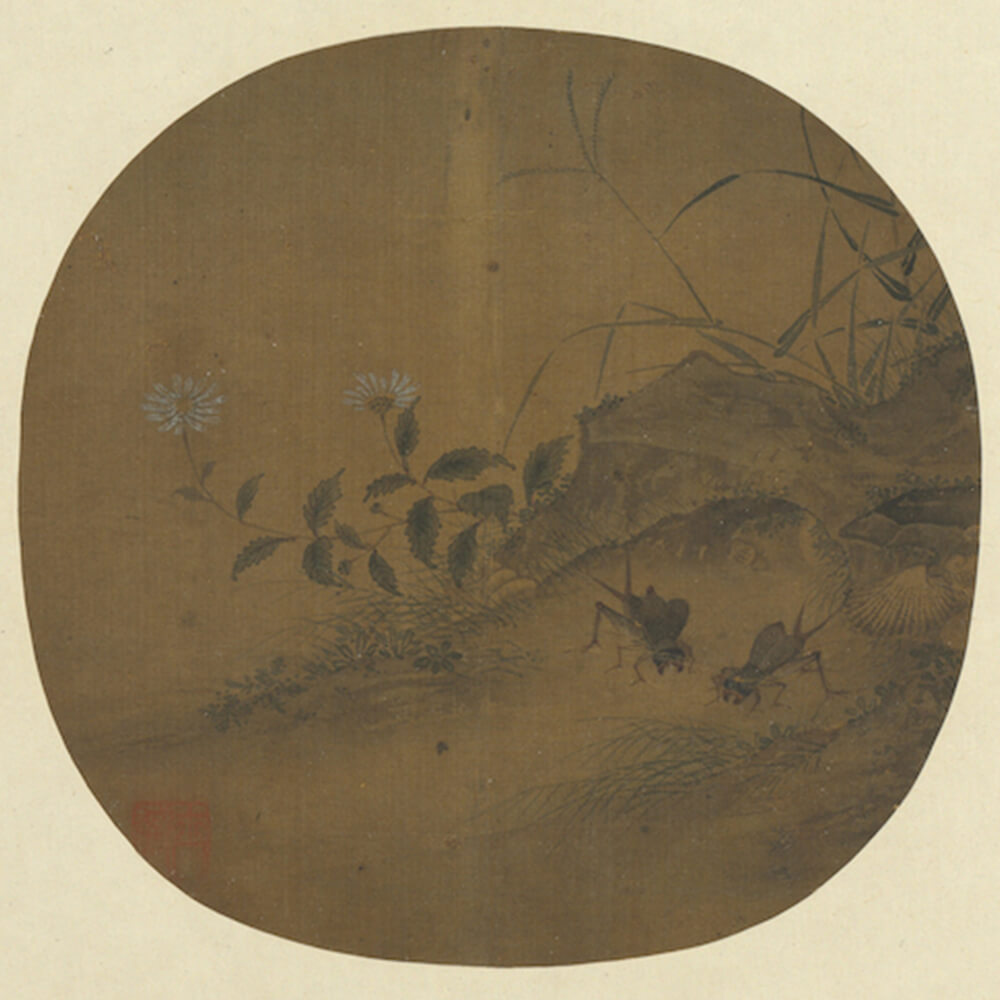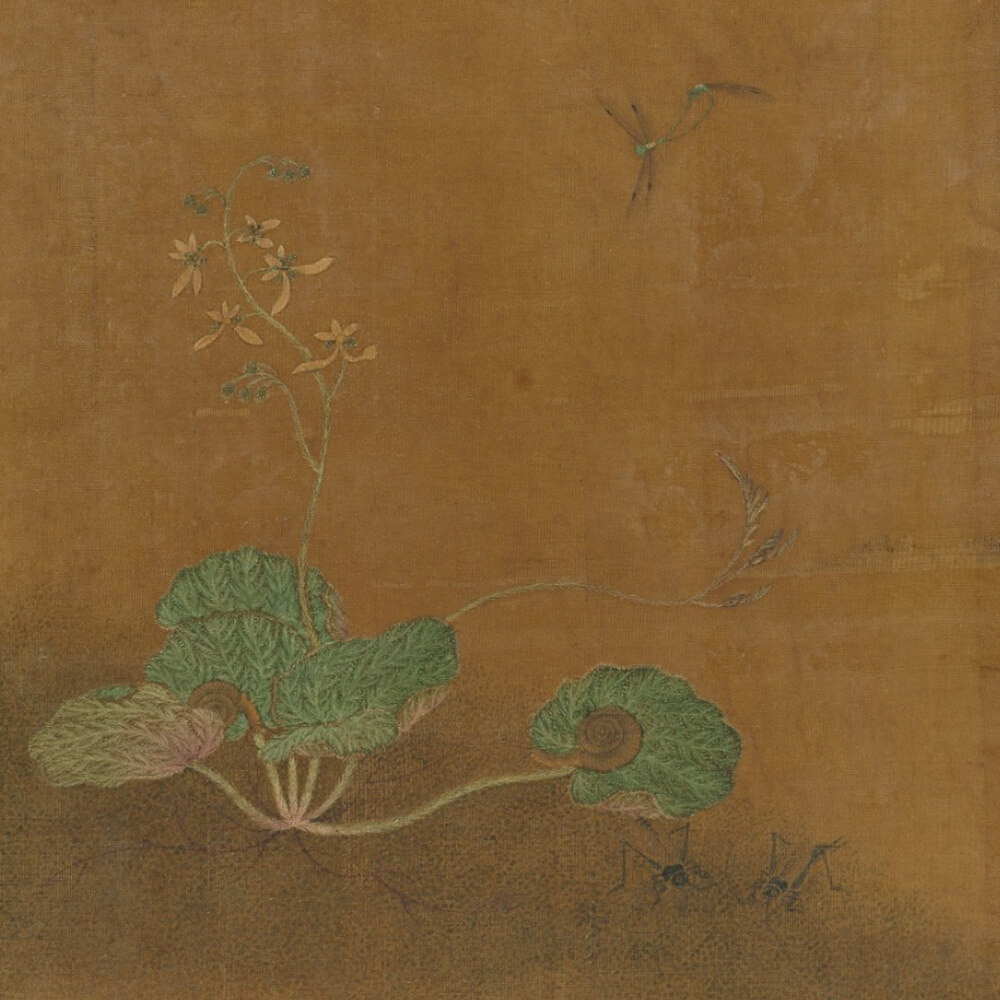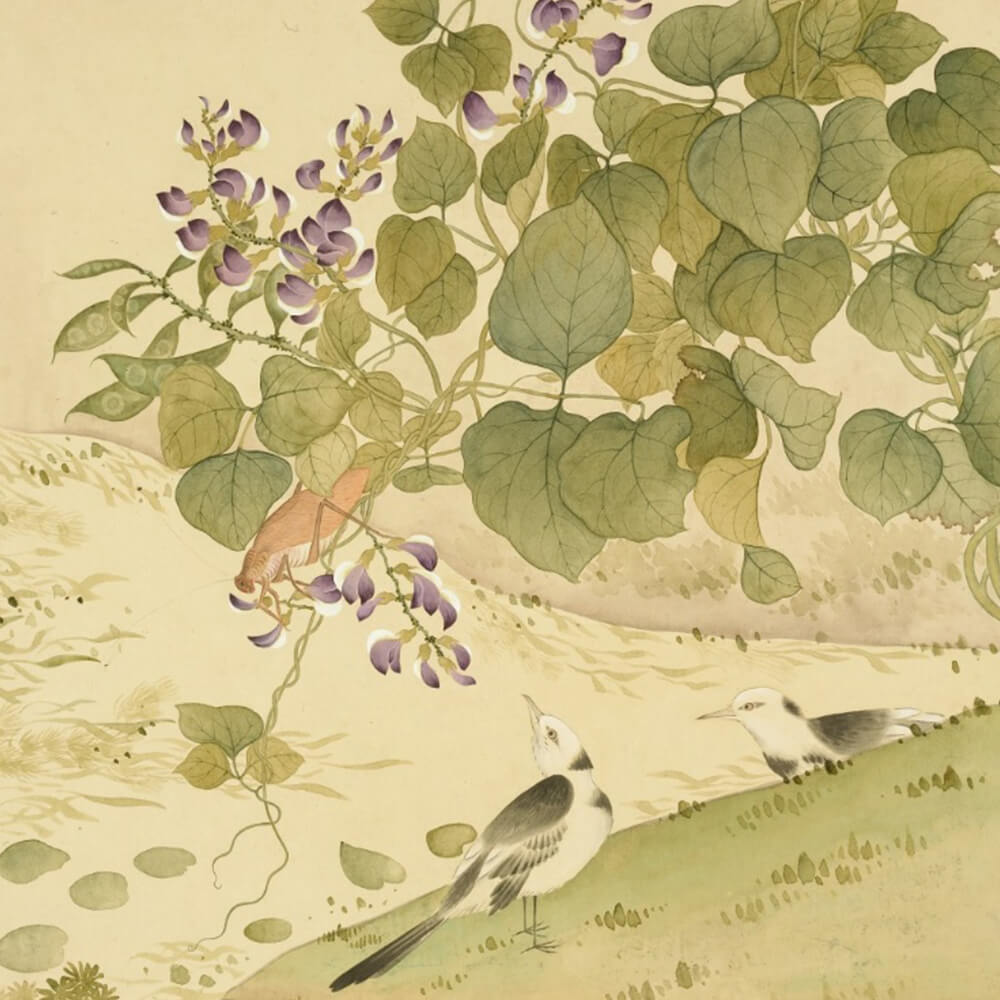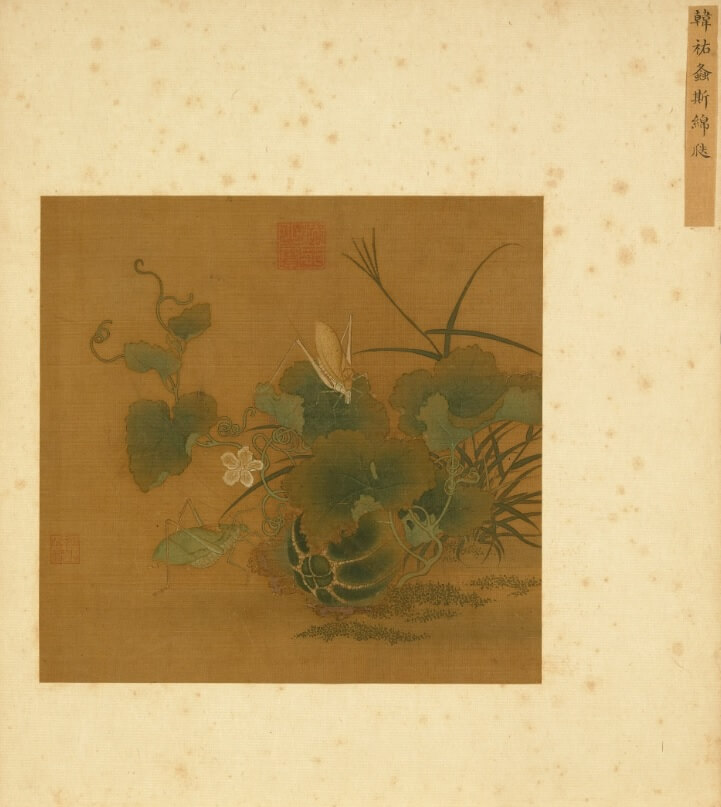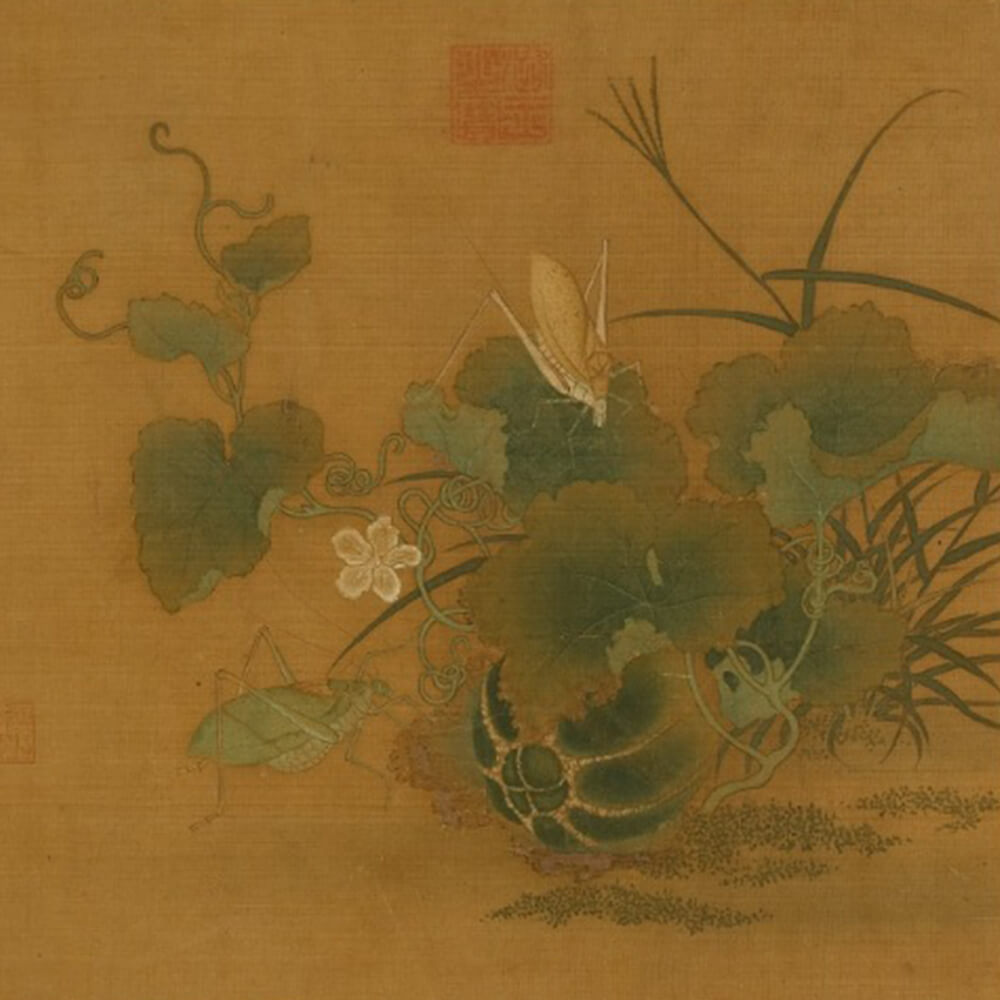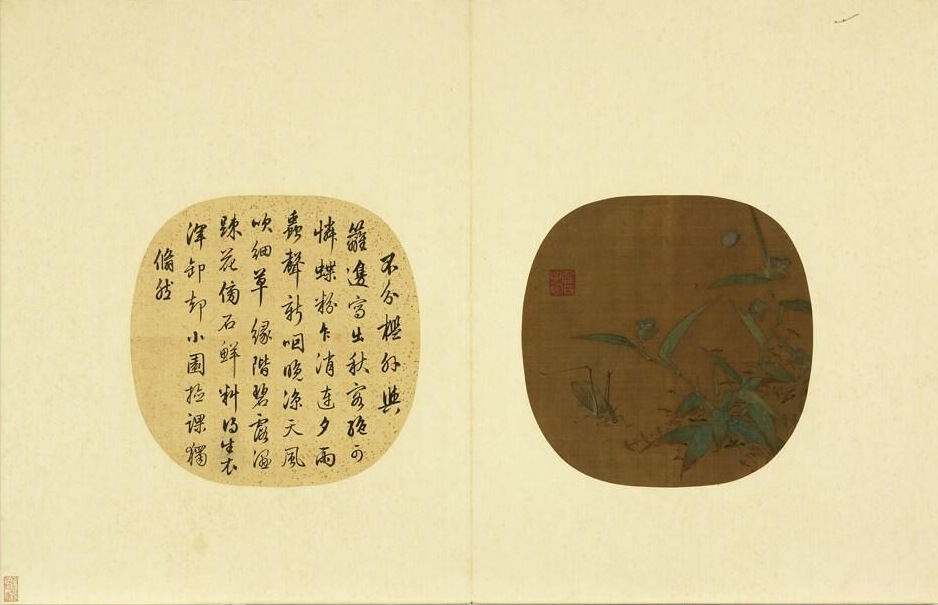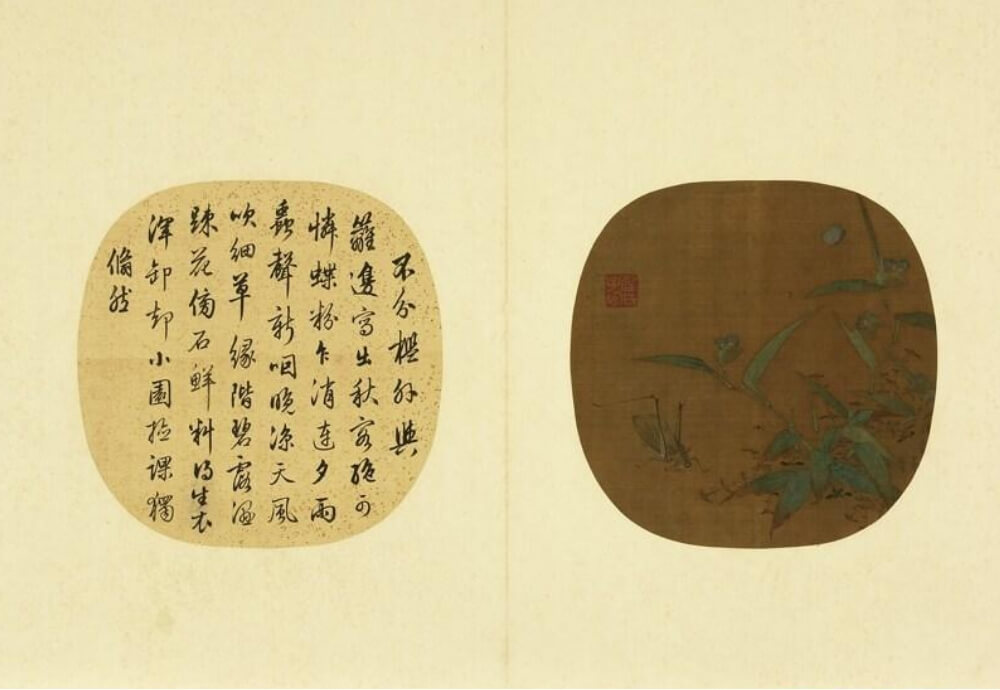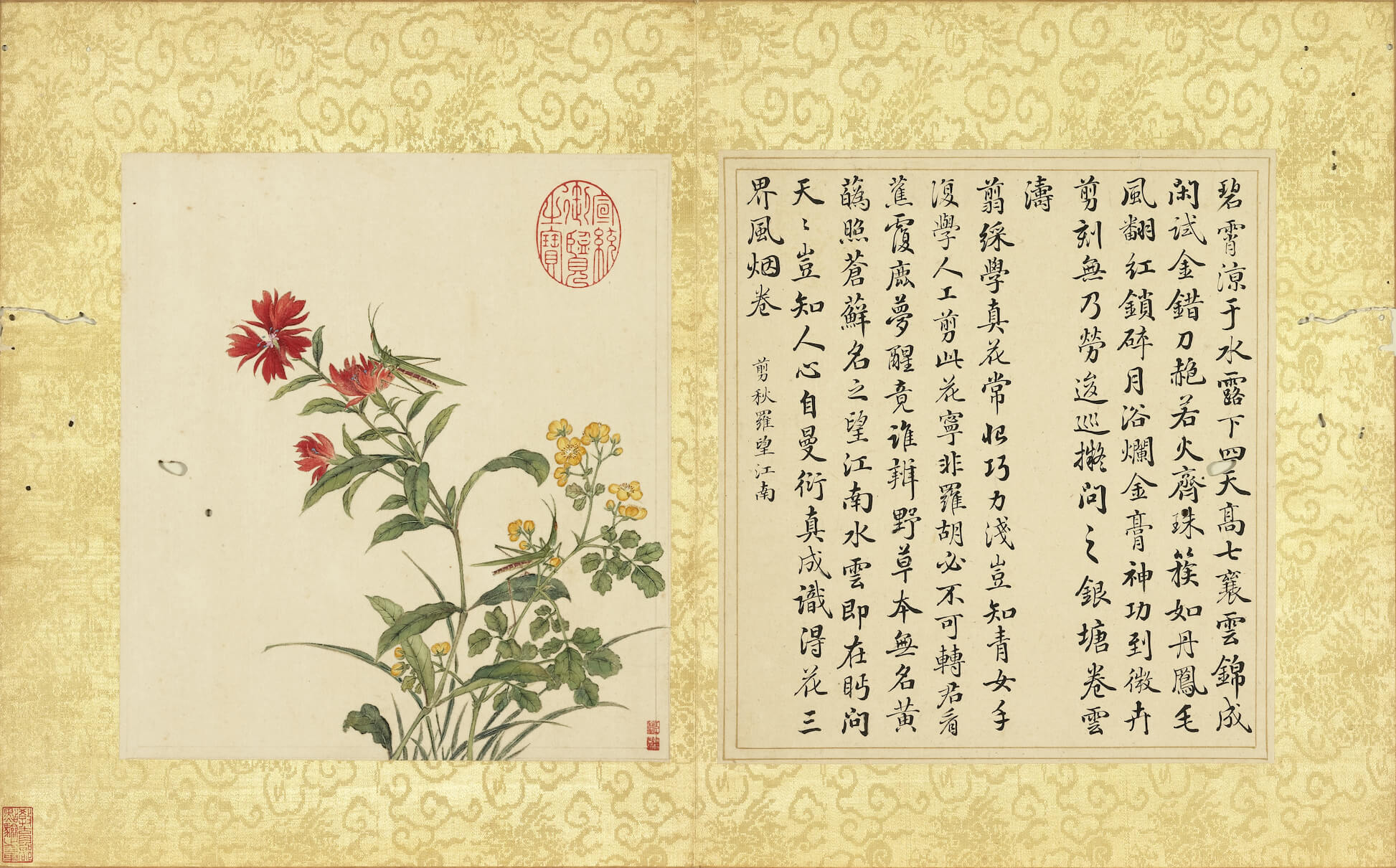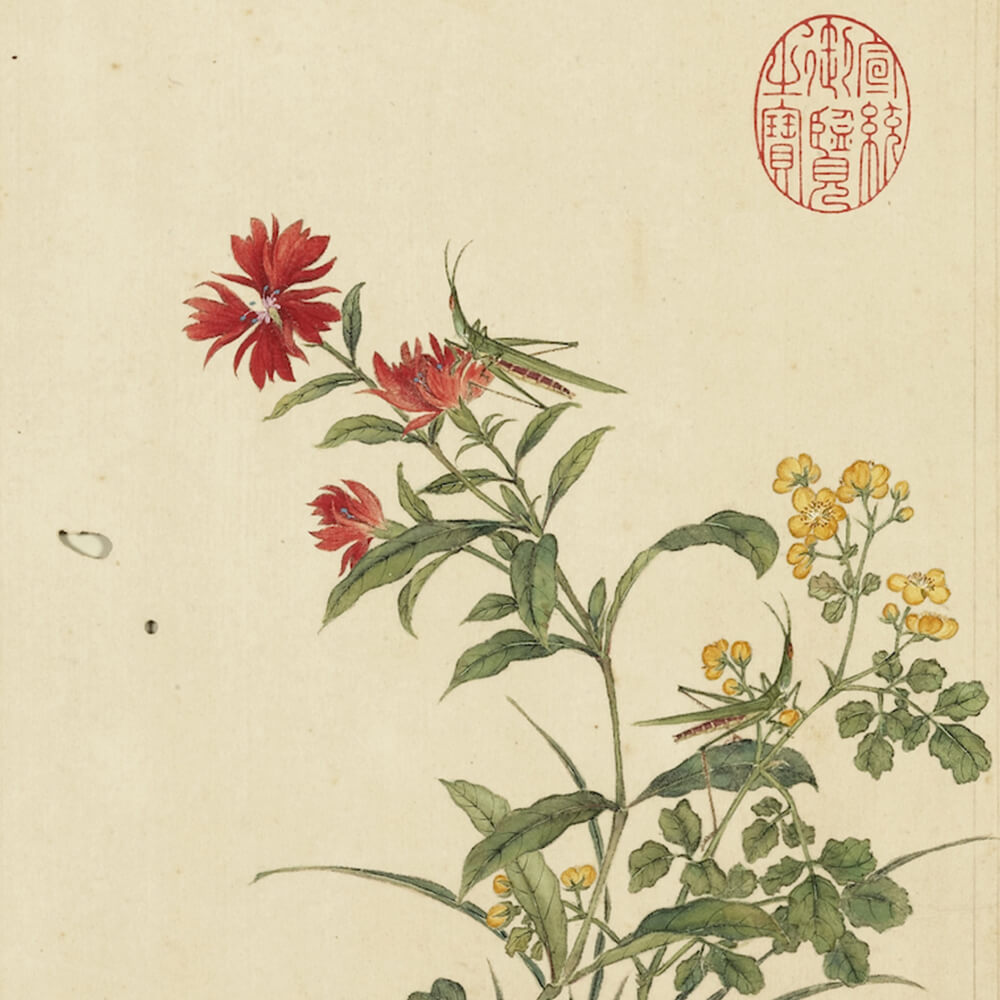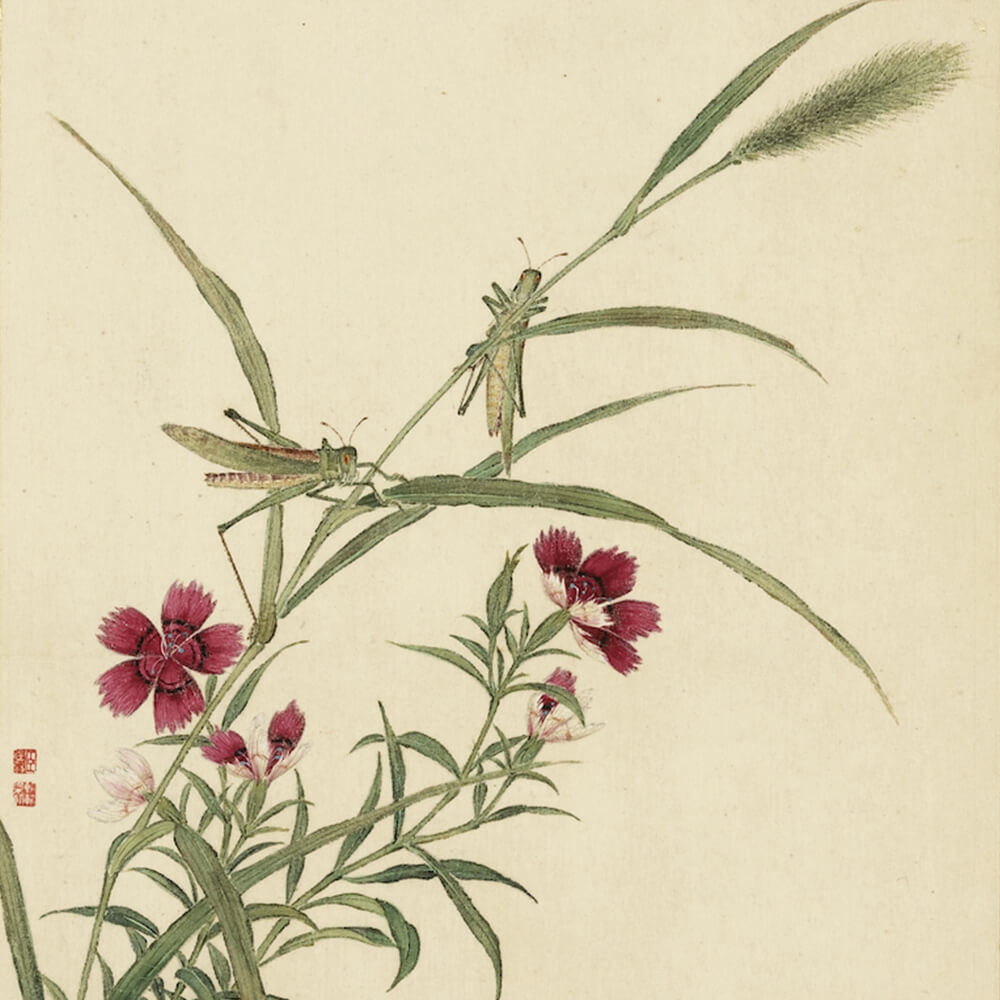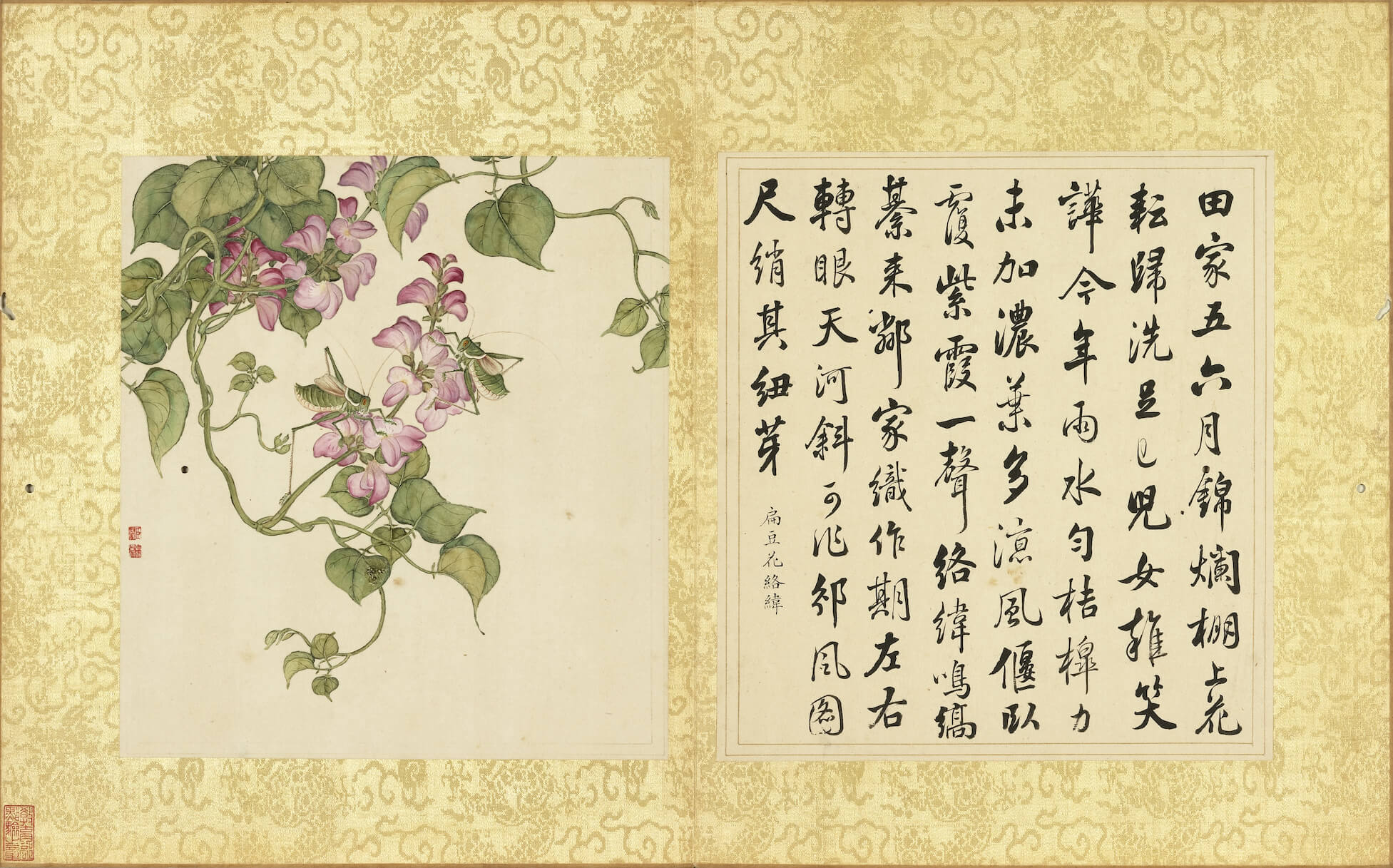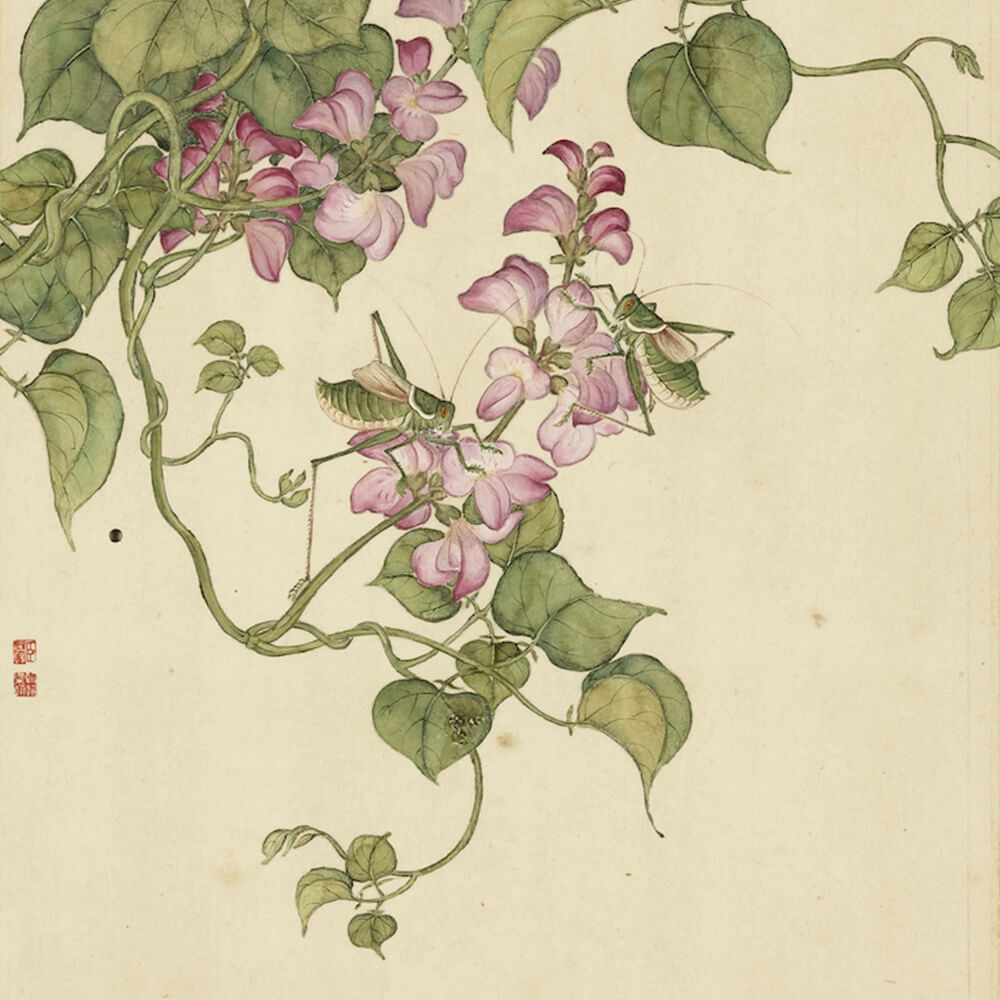The Sounds of Caochong
Insects that make sonorous buzzing sounds easily attract attention in nature. Despite the 'caocong paintings' are unable to deliver sounds, we can always sense the existence of insects. Can you recognize the insects in the paintings and the sounds they make? When you are aware of their corresponding sounds and then appreciate the art once again, isn't it possible to hear the buzzing echoing in the image and make the experience even more extraordinary?
Not all insects that make sounds are considered singing insects, but only those that can generate delightful pitches and rhythm and can be sensed by human ears, including cicadas, katydids, crickets, and grasshoppers. Different singing insects have different ways of vocalization- Cicadas contract their muscles to bend the membrane of the abdomens, causing clicking sounds by resonance. Katydids and crickets produce sounds by rubbing their leathery front wings together. Grasshoppers generate sounds by rubbing their hind legs to their front wings.
The sound-making is a way of communication among animals. The sounds of insects serve functions of attracting mates, calling for companions, alerting dangers, intimidating enemies and luring prey; meanwhile, the sounds also increase the risk of exposing their location to the predators
Grasshoppers, katydids, and crickets are all belong in the insect Order Orthoptera. Throughout the history of time, they have been given numerous common names- 'zhamong' is the other name of grasshopper; 'fangzhi niang', 'laosi niang', 'laowei', and 'guoguo' are insects similar to katydids, and 'cuzhi', 'ququ'er', 'youhulu' are names of the cricket family.
How to quickly differentiate grasshoppers, katydids, and crickets? The initial determinations are the length of antennae, body colour and the cerci. The ones with short antennae are grasshoppers, those with thin antennae longer than their bodies are katydids, and crickets also have thin antennae but with the length between the above two. Katydids are often green or some in brown with shorter cerci; crickets are usually in black-brown colour and with a pair of distinct cerci at the end of the abdomen.
- Crickets on a Grassy Slope
- Mou Yi (1178-?), Song dynasty
In this leaf from the album "Treasures in the Realm of Art", a pair of crickets perhaps looking for a meal is shown on a grassy slope with chrysanthemum blossoms. They rustle their wings to produce the sound for which they are renowned. Crickets are insects common to the season of autumn. In China, their sound has been likened somewhat to that of a spinning wheel. The sound is said to remind one that winter is not far away and that one must quickly prepare warm clothing. Thus, crickets were known in antiquity as "fast spinners". This work bears no seal or signature of the artist, but it has been traditionally attributed to Mou I. Mou I, a native of Szechwan, was good at figure painting and also interested in ancient calligraphy.
- Saxifraga
- Wang Yuan (fl. 1310-1350), Yuan dynasty
This painting depicts a blooming Saxifraga flower, along with crickets, damselflies, and snails to create an abundant visual. The Saxifraga has a fluffy expression portrayed by short and intense lines in repeat. It seems that the two crickets at the bottom right corner are preparing for a fight, in contrast to the mating damselflies above.
Although the signature is attributed to Wang Yuan, the style is different; it is more likely a piece by the Ming painter.
Open Data Download
- Wagtails and Pea Blossoms
- Li Bingde (1737-1810), Qing dynasty
Li Bingde, style name Huiren, originated from Wu county. Li specialized in flower-and-bird paintings and served in the inner court.
The painter placed a giant brown katydid on the purple pea blossom, with two wagtails downright staring with some intentions. The painting illustrates the beautiful purple blossoms, plump pea pods, katydid symbolizing everlasting offsprings, and wagtails representing brotherly bond; everything appears to be in perfect harmony that concealing a preying game that is about to happen.
- Katydids and a Melon Plant
- Han You (fl. 12th c.), Song dynasty
Han Yu, a native of Kiangsi province, served in the painting academy of the Shao-hsing era (1131-1162) under Emperor Kao-tsung. Excelling at small scenes and flowers, his representations of plants and insects followed in the style of Lin Ch'un. This leaf from the album "Collected Sung and Yüan Paintings "shows a melon plant on the ground with grass behind it. This luxuriant plant blossoms and with grass behind it. This luxuriant plant blossoms and has a large ripe fruit that evidently has attracted the attention of two katydids. This kind of small melon has long tendrils and spreads over a large area, continuously bearing fruit. Likewise, the katydid produces many offspring. Thus, when appearing in Chinese painting , they often convey the auspicious wish of having many children.
- Plants and Insects
- Huang Jucai (933-after 993), Song dynasty
This colour painting portrayed a 'laowei (katydid)' scratching head in creeping dayflowers; the image is incomplete and once trimmed. The downright corner has an additional inscription of the flower-and-bird painter- Huang Jucai from the Five Dynasties to the early Song dynasty. The painting demonstrates the style of the Ming dynasty, but the vibrant colours corresponded to the 'Huang's opulence' that stood for Huang's signature, and thus this piece was signed with Huang's name.
The depiction of a 'laowei (katydid)' scratching head with the hind leg applies the spontaneous expression to paint the light on the links of the insect's abdomen, the hair on the legs, and details such as tarsus on the tips of the feet.
- Campion Blossoms and Locusts
- Jiang Tingxi (1669-1732), Qing dynasty
Jiang Tingxi, with the style name Yangsun and sobriquet Xigu, originated from Changshu in Jiangsu Province and once served as the grand scholar of Wenhua Palace. Jiang excelled at flower-and-bird paintings and often created art under Imperial orders.
This painting centres around the campion blossoms from the Caryophyllaceae family that have crimson colour bloom in summer and autumn, and match with yellow Cassia occidentalis. The painting has two green locusts with yellow eyes and red bellies to elevate the energetic liveliness and create an enriched visual.
- Grass, Blossoms, and Grasshoppers
- Jiang Tingxi (1669-1732), Qing dynasty
This colour painting on pith paper illustrates the campion blooms, grasshopper and bristlegrass; the painter cleverly used the variations of red and green to demonstrate the subtle difference between plants and the camouflage of insects. The bristles on the stem are portrayed by individual lines as seen in painting animal's fur. The two grasshoppers are in opposite directions. One grasshopper with legs in open motion while the other with legs in close position; it is how the painter shows his control over the body structures. The two insects cling to the grass, causing the weight to pull down the grass, generating a vivid dynamic that catches the viewers' attention.
- Pea Blossoms and Katydids
- Jiang Tingxi (1669-1732), Qing dynasty
This painting illustrates the pea vines with blooms and two green insects in natural camouflage hiding among the leaves that are almost invisible at first sight. The inscription called the insects 'laowei (katydid)'- the old name for 'fangzhiniang (weaving lady)'. The name came from how the sound of their wings flapping on summer nights is similar to the weaving machine. This insect feeds on flowers and tender leaves and usually has multiple pairs of wings. The detailed depiction captures the basic characteristics and even the spiracles on the sides of their abdomens; the white line on the mouth is supposed to be the maxillary palpus of the chewing mouth part.
Open Data Download

